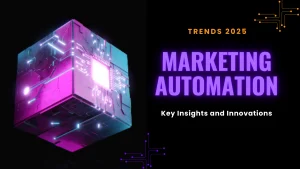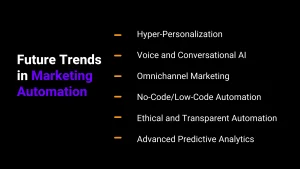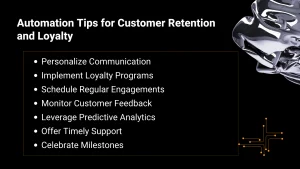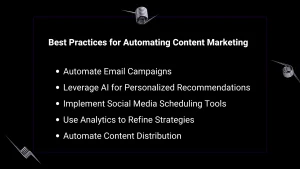2025 Marketing Automation Trends: Key Insights and Emerging Innovations
Marketing automation trends have evolved greatly, from a basic tool for email scheduling to a necessary part of contemporary digital strategies. Demand for efficient, tailored, and data-driven marketing solutions rises as businesses adjust to a competitive digital landscape. Automation helps businesses improve customer experiences, simplify processes, and achieve statistically significant outcomes on a large scale.

Several developments and innovations will change marketing automation in 2025. These developments will change how companies connect with their audiences, from predictive analytics to hyper-personalization and omnichannel engagement to artificial intelligence and machine learning.
This article examines upcoming trends and offers actionable advice for businesses to stay ahead. The marketing strategies described here will help companies stay competitive and provide value to their clients in a rapidly evolving market.
Future Trends in Marketing Automation
Driven by changes in customer expectations and technology, marketing automation keeps changing instantly. The future of marketing automation lies in the use of cutting-edge solutions to create hyper-personalized experiences, boost productivity, and remain ahead of the competition.
Hyper-Personalization and Data-Driven Marketing
Advances in data analytics will drive hyper-personalization, which will rule in 2025. Automation enhances client segmentation and behavioral marketing.
Advanced Customer Segmentation
Businesses will use increasingly precise customer data to target marketing initiatives by 2025. Data collecting and analysis advances help businesses to segment consumers not only by conventional demographics but also by complex variables such as purchase behavior, browsing behavior, and even future demands. Granularity guarantees that marketing materials resonate with targeted customer segments, boosting engagement and conversions. Such precise segmentation helps companies to predict the needs of their audience like never before and builds closer consumer loyalty.
Behavioral Data
More advanced marketing automation trends and technologies will significantly increase behavioral data use. Actions like clicks, searches, and social media interactions provide insights that will guide the creation of automated ads catered to certain activities. A customer viewing a product category online may receive a follow-up email with comparable or complimentary items, improving their purchase experience. Behavioral data will also help to forecast future trends, thereby allowing real-time consumer demand response and a customized experience at every point of contact.
Dynamic Content Delivery
Dynamic content distribution will transform client interactions by adjusting to individual tastes and habits. Content will be immediately customized depending on user data, whether via email, online interfaces, or app experiences. An e-commerce platform may recommend different products to two customers on the same page based on their preferences and browsing history. This strategy increases relevancy as well as involvement, thus strengthening the relationship between the brand and the customer. As one of the important marketing automation trends, dynamic content delivery makes every customer interaction relevant, efficient, and tailored.
Integration of Omnichannel Marketing Automation
Omnichannel marketing automation guarantees flawless and consistent communication when consumers interact on multiple platforms.
Seamless Cross-Platform Campaigns
Marketers are using email, SMS, social media platforms, and automated tools to construct campaigns that give a consistent client experience. Combining data from several platforms into a consolidated system would help companies make sure every touchpoint provides consistent messaging catered to personal preferences and activities. This method improves efficiency and consumer loyalty by providing a consistent and relevant brand experience.
Multi-Touch Attribution
Understanding the success of every engagement in the customer lifetime depends on tracking and automating multi-channel client journeys and touchpoints. Businesses may better allocate resources and modify their strategy by measuring which channels and messaging resonate. Trends in marketing automation communications make them timely and tailored, reacting to client behavior in real time. By providing consistent, customized experiences across all media, this not only increases productivity but also builds loyalty.
Consistency Across Channels
Building customer trust and recognition requires brand consistency across all platforms. Through centralizing communications and design aspects, integrated marketing automation systems significantly help to guarantee this consistency. These marketing campaigns let companies design brand-compliant marketing across platforms. Automation guarantees that every consumer touchpoint reflects the same values, tone, and visual identity. These technologies help companies create a consistent brand experience that builds consumer loyalty.
Marketing Automation Trends 2025: Automation for Customer Retention and Loyalty
Automation goes beyond simply drawing in fresh business. It also helps keep and build loyalty.
Automated Customer Journey Mapping
Market automation is changing how companies analyze and optimize client journeys. Using predictive analytics and data-driven insights can help companies trace consumer behaviors and tastes at every level of the purchasing process. Automation lets you track interactions across channels and discover crucial touchpoints where personalized content or offers might make an impact. This ensures clients receive relevant content at the right time, enhancing satisfaction and long-term engagement. By use of automated customer journey mapping, businesses may design customized experiences that fit changing consumer needs, therefore strengthening bonds and retention.
Loyalty Programs and Reward Systems
Marketing automation trends have made loyalty programs efficient and personalized, keeping customers coming back. Automated systems let companies monitor consumer preferences, behavior, and purchases to provide specific incentives and rewards. Customers can get fast alerts of points earned, tailored reward milestones, or exclusive offers depending on their buying habits. Automation also streamlines reward redemptions and enrollment procedures, thereby guaranteeing users’ flawless experience. Automating loyalty programs boosts customer engagement, repeat business, and brand loyalty.
Post-Purchase Engagement
The consumer relationship simply starts; it does not stop following the first purchase. Marketing automation trends help companies communicate with customers after purchase, creating repeat business and long-term partnerships. Automation tools can be set off to thank consumers for their purchases, provide useful advice on product use, or suggest complementary items depending on purchase behavior. To show customer care, businesses can plan and deliver tailored messages to request feedback or perform satisfaction surveys. Automated social media marketing builds confidence, inspires customer loyalty, and helps establish the brand as the go-to answer for upcoming needs.
Voice Search and Conversational Marketing
Smart speakers and voice assistants are influencing marketing automation trends due to their popularity. With more natural, conversational searches than conventional text-based searches, voice search has altered how consumers interact with search engines. Businesses must now optimize their content for voice search using long-tail keywords, question-based formats, and local search intent. Marketing automation systems are also adapting to voice-first experiences, enabling businesses to deliver seamless, voice-friendly interactions that match customer expectations.
Conversational Marketing
Trends in marketing automation for AI-powered chatbots and messaging systems have transformed the way businesses engage with customers. These tools help companies to respond instantly, answer questions, and effectively assist consumers across the customer experience by supporting real-time dialogues. Conversational marketing creates meaningful consumer connections at scale through personalization. Maintaining a human-like, on-demand presence, this technology enables companies to create trust, nurture leads, and drive conversions whether through AI chatbots on websites, messaging applications, or even voice assistants.
Voice-activated shopping is revolutionizing e-commerce automation. Thanks to developments in voice recognition technologies, consumers may now easily search, explore, and buy products using just basic voice requests, therefore facilitating online shopping. Leveraging this trend, marketing automation platforms are including voice-based personalizing, simplified checkout systems, and customized product suggestions into their offers. This new method of interaction improves user experience and helps brands understand consumer preferences for more targeted and effective marketing efforts.
No-Code/Low-Code Automation
No-code and low-code platforms let marketers develop and automate workflows without programming, revolutionizing digital campaigns. With these tools, marketers may automate lead generation, email sequences, and social media posts, saving time and money. Eliminating the requirement for intricate coding allows no-code and low-code automation to unleash more creativity and efficiency throughout marketing strategies.
The Role of Data Privacy and Security in Marketing Automation
Customer trust is essential, especially as data security concerns grow. Businesses can keep compliance and foster trust with marketing automation trends.
Compliance with Regulations
Data privacy laws like the GDPR and CCPA must be followed in automated marketing strategies. These rules demand that companies treat consumer data honestly, have appropriate permission, and provide consumers control over their data. Automation systems can track consent, set data retention regulations, and provide audit-ready reports, simplifying compliance.
Building Trust with Customers
In a market going more and more digital, open data policies are crucial for building consumer confidence. Companies are using automation to provide clear privacy rules, real-time data usage updates, and quick opt-in and opt-out options for customers. Automated answers also provide tailored interactions honoring user preferences without sacrificing privacy.
Data Security Innovations
Automation is crucial to protecting client data during marketing. Modern security systems guarantee that data stays under control against illegal access or breaches with automated encryption, frequent software upgrades, and anomaly detection. Marketing automation tools can also monitor and discover weaknesses in real time, helping companies prevent security vulnerabilities.
Automation in Content Marketing
Artificial intelligence and machine learning ease content generation, distribution, and analysis in content marketing automation. Companies can focus on content creation by automating email marketing, social media publishing, and content scheduling. Marketing automation software may also examine enormous volumes of data to offer actionable insights, helping marketers to spot trends, grasp audience behavior, and design very tailored campaigns. Predictive analytics improves marketing efforts by suggesting audience-friendly content themes and formats. Marketing automation trends are turning content marketing into a data-driven, scalable approach through efficiency and accuracy, therefore assuring that companies can reach the correct people at the correct moment.
The Future of Marketing Automation Tools and Platforms
AI and Automation Platforms
Advanced AI technologies are changing marketing automation. Automating and customizing content with AI helps marketing. Future marketing automation trends include predictive analytics, conversational AI, and chatbots that change customer interaction. As AI advances, these platforms will help companies run better, faster, and more adaptively to market shifts.
Consolidation of Marketing Tools
Platforms for marketing automation are developing into all-in-one solutions that streamline company campaign management. These tools replace several systems by integrating email marketing, lead nurturing, analytics, and social media management. With a consolidated interface for all marketing tasks, this lowers expenses and increases output.
Integration with CRM and ERP Systems
Marketing automation must be integrated with CRM and ERP platforms to unify business activities. This connection guarantees flawless data flow in operations, marketing, and sales, therefore offering an entire picture of client interactions and procedures. It lets marketers design data-driven, tailored programs that improve efficiency and customer satisfaction.
Get Ahead with Marketing Automation
Many innovative ideas and marketing automation trends that companies cannot afford to ignore will help to define the marketing automation scene in 2025. Hyper-personalization will rise as AI and machine learning algorithms create client experiences based on real-time preferences and actions. Additionally, front and center will be predictive analytics, which will enable companies to act proactively and precisely forecast consumer wants.
Businesses should invest in cutting-edge technologies and train their personnel to use automation to keep ahead of these trends. Maintaining a competitive edge will mostly depend on giving customer-centric initiatives top priority and remaining flexible to fit changing digital environments. Businesses may lead the fast-changing marketing automation field by proactively integrating these advancements.
Start integrating Webugol’s cutting-edge marketing automation solutions into your business strategy to stay ahead of the competition and drive success in 2025.





